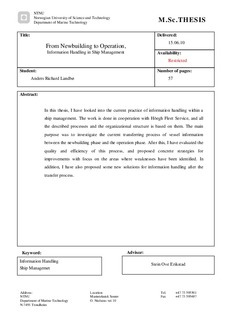| dc.description.abstract | In this thesis, I have looked into the current practice of information handling within a ship management. The work is done in cooperation with Höegh Fleet Service, and all the described processes and the organizational structure is based on them. The main purpose was to investigate the current transferring process of vessel information between the newbuilding phase and the operation phase. After this, I have evaluated the quality and efficiency, and also proposed concrete strategies for improvements in this process.
I have assessed two of the more common processes that regularly are performed by the technical ship management. These are: "Procurement of equipment and goods to the vessels", and "the drydocking process". The reason for this was to investigate the flow of information between the participants involved, and to identify the origin of the information exchanged and used in these two processes.
Then, I have looked at the used information which in these processes is originated from the newbuilding phase to see how this currently was transferred and implemented into the operation phase. In two areas, I have identified potential room for improvements. The first was in the transfer and handling of warranty agreements, and the second was in the implementation of digital manuals and drawings. In addition to this, I also learned that there was a desire to improve the transfer of history and experience from a vessel between the different participants involved throughout its entire lifetime.
In the third part, I have stated the best possible result after the process of transfer and implementation of information from newbuilding to operation. This was with regards to the areas where I previously had identified potential room for improvement. In addition, I have also looked into how history and experience should be saved and exchanged between the different participants involved during the vessels lifetime.
In the final part, I have proposed concrete solutions and strategies that in the best manner meet the "best result" statement. These solutions emphasizes not to make too many changes to the already existing systems, and to be easy to implement and use. | nb_NO |
